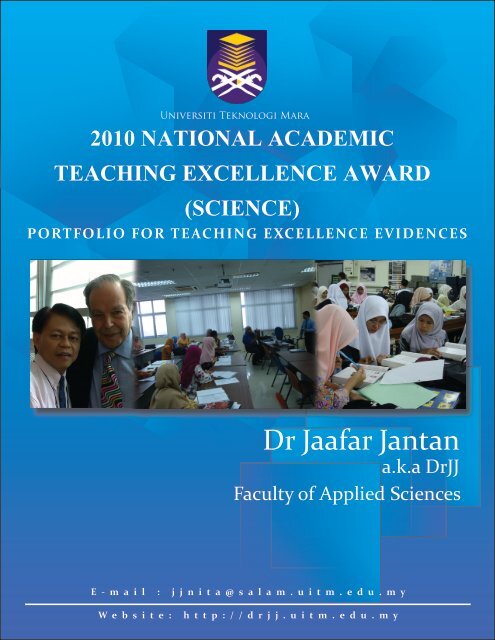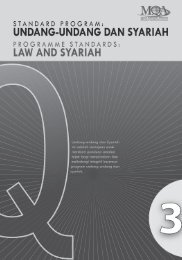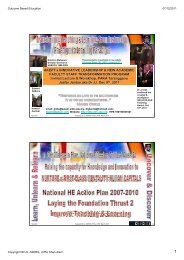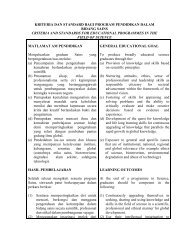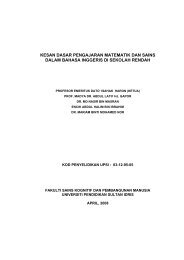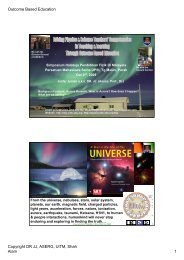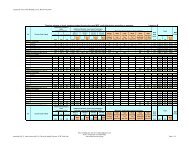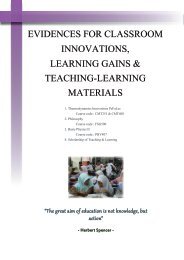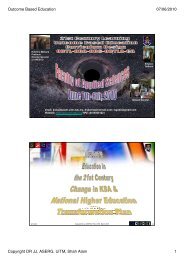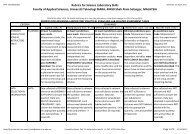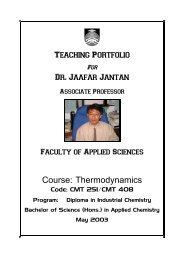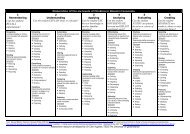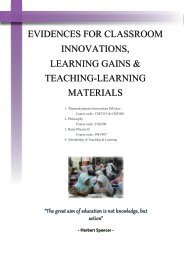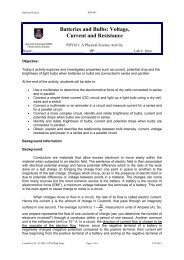My Teaching Philosophy - DrJJ - UiTM
My Teaching Philosophy - DrJJ - UiTM
My Teaching Philosophy - DrJJ - UiTM
Create successful ePaper yourself
Turn your PDF publications into a flip-book with our unique Google optimized e-Paper software.
Universiti Teknologi Mara<br />
2010 NATIONAL ACADEMIC<br />
TEACHING EXCELLENCE AWARD<br />
(SCIENCE)<br />
PORTFOLIO FOR TEACHING EXCELLENCE EVIDENCES<br />
Dr Jaafar Jantan<br />
a.k.a <strong>DrJJ</strong><br />
Faculty of Applied Sciences<br />
E - m a i l : j j n i t a @ s a l a m . u i t m . e d u . m y<br />
W e b s i t e : h t t p : / / d r j j . u i t m . e d u . m y
DR jj’s teaching philosophy<br />
&<br />
teaching and learning<br />
innovations<br />
- DR. JJ -<br />
J ourney towards<br />
E nrichment and<br />
B alance by utilizing<br />
A rts and sciences in<br />
T eaching and learning<br />
“If you are, you breathe. If you breathe, you talk.<br />
If you talk, you ASK. If you ask, you THINK.<br />
If you think, you SEARCH. If you search, you EXPERIENCE.<br />
If you experience, you LEARN. If you learn, you GROW.<br />
If you grow, you wish. If you wish, you FIND.<br />
If you find, you DOUBT. If you doubt, you QUESTION.<br />
If you question, you UNDERSTAND. If you understand, you KNOW.<br />
If you know, you want to know more.<br />
And if you want to know more, YOU ARE ALIVE”<br />
- National Geographic -
http://drjj.uitm.edu.my<br />
AAN-<strong>DrJJ</strong>-Jan2011-<strong>Teaching</strong> <strong>Philosophy</strong> & <strong>Teaching</strong> Innovations<br />
<strong>Teaching</strong><br />
<strong>Philosophy</strong><br />
& <strong>Teaching</strong><br />
Innovations<br />
Authored by Associate<br />
Professor Dr. Jaafar<br />
Jantan aka Dr JJ, FSG,<br />
Universiti Teknologi<br />
MARA. January 2011<br />
Edited May 2011<br />
http://drjj.uitm.edu.my<br />
email: jjnita@salam.uitm.edu.my<br />
Page 1 of 24
http://drjj.uitm.edu.my<br />
AAN-<strong>DrJJ</strong>-Jan2011-<strong>Teaching</strong> <strong>Philosophy</strong> & <strong>Teaching</strong> Innovations<br />
<strong>Teaching</strong> <strong>Philosophy</strong> &<br />
Innovations of Classroom TLAs<br />
by<br />
Dr. Jaafar Jantan aka Dr JJ<br />
Associate Professor<br />
Faculty of Applied Sciences<br />
Universiti Teknologi MARA<br />
Diploma & Bachelor of Science (Hons.) Classroom Courses:<br />
1. Thermodynamics. Innovation-PeFaLeC<br />
2. <strong>Philosophy</strong> of Science. Innovation-APPIE<br />
3. Basic Physics. Innovation-5Es & PODS<br />
Page 2 of 24
http://drjj.uitm.edu.my<br />
AAN-<strong>DrJJ</strong>-Jan2011-<strong>Teaching</strong> <strong>Philosophy</strong> & <strong>Teaching</strong> Innovations<br />
TEACHING PHILOSOPHY<br />
I have been teaching at <strong>UiTM</strong> since January 1987. In my earlier days of teaching, I resorted<br />
to only one approach of teaching, the Traditional Approach or the Transmittallist approach.<br />
After all, I am what I am today, after experiencing this type of instructional approach when I<br />
was a university student. This approach of teaching employs direct instruction, follows a<br />
cookbook lab manual and solves textbook problems for and at times with the students in<br />
tutorial sessions. It is commonly used by teachers at high school and at the universities. In<br />
other words, I taught using approaches of how I was taught as a student.<br />
<strong>My</strong> Novice Approaches To <strong>Teaching</strong><br />
When I began my career as a university teacher, I found myself struggling in “preparing” for<br />
my classes. I was only guided by prescription detailed in the course syllabus; a list of topics<br />
and subtopics similar to those found in textbooks The struggling I experienced, happened<br />
regardless of whether I was teaching a low-level physics class in the learning areas of<br />
mechanics or teaching the more advanced learning area of modern physics. I struggled<br />
because I had problems in understanding concepts, principles and generalizations of those<br />
principles. While I was able to define concepts, draw graphs and labeled its axis with<br />
quantities and units, solved many textbook problems that required me to use physics<br />
equations or derived physics relationships from fundamental equations, I failed to explain<br />
much of what I did. In other words, my conceptual knowledge was just at the proficient level,<br />
at best. It would have been very helpful if my understanding was deep rather than surface. It<br />
would have been very helpful that I could state, defined, described, able to provide in-depth<br />
explanation, provided reasons along with specific examples to clarify vague problems and if I<br />
could offer a few alternatives in solving problems. Not only that, it would have been really<br />
helpful if I could convince myself and my peers as to what, how and why I chose certain<br />
solutions for a given problem.<br />
Often, as a student, I never saw what the end product of courses will be except to receive a<br />
grade that would indicate my competency in the courses I took. Indeed, I did very well and<br />
getting good grades in the mathematics, the physics and other science courses I took but I<br />
did not understand the concepts well enough and I did not understand how the concepts<br />
were linked to each other especially from one learning area to another.<br />
<strong>Teaching</strong> is aimed at producing change. Changes are to be achieved not only in the<br />
cognitive domain but also in the practical skills and in enhancing the emotional intelligence of<br />
the students. <strong>Teaching</strong> is supposed to help learners change from a novice state to a state<br />
short of being an expert in a certain discipline. <strong>Teaching</strong> is a process that will push the<br />
content as the input to achieve the goal and the outcomes of a course. The ultimate prize,<br />
then, is the take-away from any learning experiences. What counts is not just the grade but<br />
the functional knowledge, the ability to use the knowledge and understanding that students<br />
will take with them after the completion of a course. It is the ability to apply the knowledge<br />
and understanding in analyzing authentic problems related to the discipline and those that<br />
are related to living and to their carrer. The take-away or products of education can be<br />
achieved only if the appropriate and aligned teaching activities are employed and the aligned<br />
assessment strategies are employed to assess the change or achievement of the learners.<br />
Hence, teaching must strive for the learners to be able to know and be able to perform by<br />
utilizing what they know. The oft-cited National Geographic commercial “Live Curious” ought<br />
Page 3 of 24
http://drjj.uitm.edu.my<br />
AAN-<strong>DrJJ</strong>-Jan2011-<strong>Teaching</strong> <strong>Philosophy</strong> & <strong>Teaching</strong> Innovations<br />
to be a driving force in any learning experiences at all certification levels. I quote below the<br />
phrases from the commercial:<br />
“If you are, you breathe. If you breathe, you talk. If you talk, you ASK. If you ask,<br />
you THINK. If you think, you SEARCH. If you search, you EXPERIENCE. If you<br />
experience, you LEARN. If you learn, you GROW. If you grow, you wish. If you<br />
wish, you FIND. If you find, you DOUBT. If you doubt, you QUESTION. If you<br />
question, you UNDERSTAND. If you understand, you KNOW. If you know, you<br />
want to know more. And if you want to know more, YOU ARE ALIVE…”<br />
MY CONVERSION<br />
When I was doing my PhD in physics in 1991, I found out that the lack of understanding was<br />
preventing me from solving advanced and complex problems in areas of electromagnetism,<br />
mechanics and quantum mechanics. The challenges were more pronounced when I took the<br />
compulsory comprehensive examinations to qualify me to become a PhD candidate at the<br />
Physics Department. For this reason alone, I embarked on a journey towards learning how to<br />
teach and assess meaningfully by taking classes in the Education Department and by<br />
choosing to do my research in Physics Education, a stark contrast to my experiences and to<br />
my initial goal. That marked the beginning of a whole new experience and there was no<br />
turning back after that. I took it upon myself to shift and transform from a surface and<br />
strategic learner to a deep learner; questioning my existing mental models and probing for<br />
ways to learn, unlearn and relearn<br />
Today, 16 years after I earned my doctoral degree in Physics Education from the Physics<br />
Department, Kansas State University, I am a classroom practitioner who combined both the<br />
art and science of teaching while coaching my “students” in achieving the learning outcomes.<br />
Today, my teaching and learning is guided by my belief:<br />
“Journey towards Enrichment & Balance by utilizing Arts and sciences in <strong>Teaching</strong> and learning,<br />
acronymed JEBAT.”<br />
For the past 20 years, I have been utilizing the literature in physics education research<br />
(PER), psychology, assessment and education research-validated best practices to practice<br />
constructively aligned teaching and assessment and ensure attainment of lesson and course<br />
learning outcomes. Occasionally, I try to contribute to the literature. Over the same period, I<br />
have also honed my presentation and communication abilities in speaking, listening and<br />
recognizing the non-verbal and the unspoken signals the students are sending me during<br />
class sessions. I believe that the Art of <strong>Teaching</strong> is an important, effective and necessary<br />
tool in creating a fun, harmonious, respectful and active classroom environment. Hence, in all<br />
of my classes, I engaged the students in the learning process, making them activate the<br />
action verbs they are supposed to acquire upon completion of the lesson. To this end, I<br />
created an extensive physics Lesson Learning Outcomes (LLOs) for each learning area in<br />
order to help the students achieve the Course Learning Outcomes (CLOs) and to guide their<br />
learning during the face-to-face and non face-to face learning activities. To date, the lesson<br />
learning outcomes for various physics themes that I generated are applicable at the<br />
matriculation, diploma and first year university courses.<br />
Page 4 of 24
http://drjj.uitm.edu.my<br />
AAN-<strong>DrJJ</strong>-Jan2011-<strong>Teaching</strong> <strong>Philosophy</strong> & <strong>Teaching</strong> Innovations<br />
Meaningful learning in a classroom or lecture hall is greatly assisted when the coach or<br />
lecturer is an excellent communicator. It is only natural that communication plays a vital role<br />
in engaging the students. As part of communicating, I believe that all teachers must attempt<br />
to be personal with all the students in order to command meaningful classroom and out of<br />
class communication. To this end, I have and still require students to share with me their<br />
personal biodata which include their family background, their vision and mission in life, their<br />
interests, their academic background, courses they learn most and least so far, reasons for<br />
learning most and least, suggestions on how they would change the teaching and learning in<br />
the courses they learn least and their expectations for the course they are presently taking.<br />
Often, the students will do a brief introduction during the first day of class where they will<br />
quickly introduce their commercial name, their family background, whether or not they have<br />
their own durian and rambutan trees near their homes and if they are committed in a<br />
relationship. I usually follow-up the brief introduction with a request that they email me a<br />
more detail account of themselves along with their photo. The photo helps me to identify<br />
them by name while in class especially when the number of students in the class exceeded<br />
30. Having the students’ biodata helped me to become personal with the students on a<br />
commercial name basis. This leads to class sessions that are more of an intellectual<br />
gathering among extended family members who share the same goal, rather than just<br />
another formal academic classroom.<br />
Complementing the Arts of <strong>Teaching</strong> is the science of learning. The science of learning<br />
involves utilizing research-validated practices in pedagogy and assessment that are<br />
developed and proposed by psychologists and educationists. In my case, it is researchvalidated<br />
practices in Physics Education Research or PER (since I am a physics teacher)<br />
developed by researchers such as Arnold Arons, Robert Karplus, Lilian McDermott, Edward<br />
Redish, Leon Lederman (physics Nobel recipient), Richard Hake, Dean Zollman, Priscilla<br />
Laws, David Sokoloff, Ron Thornton, Carl Weiman (physics Nobel recipient), and Eric Mazur,<br />
just to name a few.<br />
Robert Karplus was the physicist who gave up doing hard core (fundamental nuclear<br />
physics) physics research and shifted to PER. He initiated the use of The Learning Cycle in<br />
teaching high school physics science which is later adopted for science education at tertiary<br />
level. Eric Mazur, a physics Professor at Harvard introduced Peer Instruction Instructional<br />
Approach (the reader may be more familiar with the think-pair-share instructional approach)<br />
at Harvard University after he discovered that his physics students failed to proficiently<br />
demonstrate conceptual understanding even though they are good at solving algorithm and<br />
quantitative problems. Carl Weiman, the 2003 Physics Nobel recipient, started a physics<br />
education research group at the University of Colorado, Boulder and his group developed a<br />
range of simulations to allow a more visual approach in understanding of physics and<br />
science concepts and principles. Today, Prof Weiman heads the Education group at British<br />
Columbia to find ways of improving and aligning the curriculum, the teaching and learning<br />
and the assessment methods in mathematics and sciences for undergraduate education. His<br />
effort has earned him a spot as an Associate Director to Obama’s administration responsible<br />
to design and implement science initiatives in undergraduate education for the North<br />
American universities.<br />
Another influential Physics Education Researcher is Priscilla Laws (along with David Sokoloff<br />
& Ron Thornton) who started Workshop Physics where computers are used as enablers for<br />
learning in lecture-free, workshop style, calculus-based physics courses at the Dickinson<br />
College. These pedagogical approaches are the product of physics education research<br />
which is guided by findings from psychology findings into how the human brain works and<br />
how people learn.<br />
Page 5 of 24
http://drjj.uitm.edu.my<br />
AAN-<strong>DrJJ</strong>-Jan2011-<strong>Teaching</strong> <strong>Philosophy</strong> & <strong>Teaching</strong> Innovations<br />
A significant contribution to the science of learning involved learning theories proposed by<br />
constructivists and in part, the Theory of Intelligence by Sternberg and of Multiple<br />
Intelligences by Howard Gardner. Constructivists assert that learners learn best if they built<br />
on an existing mental models and schemata as suggested by Piaget. In fact, learning is a<br />
scaffolding process and new knowledge can only be constructed or understood if it is built<br />
upon existing knowledge. Research evidences strongly suggest that if the existing<br />
knowledge is non-scientific or misconceived, it will interfere with meaningful learning of new<br />
knowledge. This interference usually manifests itself in the form of memorization and<br />
regurgitation.<br />
As part of promoting deep approach to learning, I adopted the use of diagnostic tests to<br />
probe and identify any existing misconceived or Aristotelian physics knowledge before I<br />
began my classes. The diagnostic instruments used are called Concept Inventories (see for<br />
example the oft-cited Force Concept Inventory and the Force Motion Conceptual Evaluation)<br />
which were developed through scientific, research-validated processes. <strong>My</strong> teaching and<br />
learning approaches are designed by first considering the misconceived knowledge revealed<br />
from the diagnostic tests. If indeed the concept and understanding is Aristotelian and nonscientific<br />
then I will create a classroom scenario where students undergo a conflict in their<br />
belief system and begin to QUESTION the validity of their existing mental models. Alvin<br />
Toffler refers to this situation as the process of unlearning in order to enable a relearning<br />
process to take place. This stage is a critical stage, yet overlooked by many teachers. In fact,<br />
using the research-validated CIs as pre-post assessment tools will help identify the<br />
effectiveness of instructional approaches. In addition, the learning gains obtained from the<br />
pre-post assessment can serve as indicators towards course and program improvement.<br />
Page 6 of 24
http://drjj.uitm.edu.my<br />
AAN-<strong>DrJJ</strong>-Jan2011-<strong>Teaching</strong> <strong>Philosophy</strong> & <strong>Teaching</strong> Innovations<br />
MY EXISTING TEACHING & LEARNING<br />
APPROACHES<br />
Even though identifying the misconceived beliefs or existing mental model is crucial to<br />
promote learning, it is also equally important for me and for the students to identify their<br />
strength and weakness in the eight intelligences. The way we teach should involve the most<br />
efficient way that students receive, perceive, process and understand information. Hence, I<br />
subscribe to Felder’s Inventory of Learning Styles to identify the students learning<br />
preferences. From the findings of Learning Preferences Inventory, I found that 80% of the<br />
students are visual learners rather than verbal learners. As a result, I minimize the use of<br />
textual information and my own continual talking to the students during class sessions.<br />
Instead, I talk WITH the students utilizing concrete and visual representation of concepts.<br />
In addition to identifying student’s learning preferences, I also advocated the use of Concept<br />
Mapping (CMAP) by using the IHMC software (interested reader can google up IHMC CMAP<br />
to download the free software) so that students may construct a visual representation of<br />
concepts, objects and events that they know. The CMAP connect concepts via linkwords to<br />
form propositions in a hierarchical manner. Propositions are just sentences that connect<br />
concepts together via link-words. In a way, this is quite similar with the more familiar Mind<br />
Mapping but the strength of CMAPs are the propositions where linkwords are used to<br />
connect two concepts together. During the first or second class session, students are given<br />
practice on how to construct simple CMAPs manually and by using the IHMC software. After<br />
the skills begin to strengthen, students will then advance to CMAPs that will involve<br />
combining together concepts from various learning areas. The learning sessions involve<br />
students choosing concepts and linkwords from a pool of concepts and linkwords and match<br />
them in blank boxes provided in the CMAP. As they become more familiar with the mapping<br />
process, they will begin to use the IHMC CMAP software to construct their own CMAPs.<br />
The use of a variety of teaching approaches that involve students’ active engagement is what<br />
active learning is all about. It involves making the students actively engage with the action<br />
verbs they are supposed to know and able to do. While most students are active learners in<br />
ways that they process new information, the method to be active can take on a variety of<br />
techniques ranging from a normal dialogue to musical or scripts in a drama. The cycle of<br />
active learning consist of making observations, engage in self dialogues and followed by<br />
engaging in peer dialogues in the attempt to process information especially the abstract<br />
information, before deep and meaningful understanding can take place.<br />
In promoting students to capitalize on technology and Information Communication<br />
Technology as enablers for teaching and learning and as tools for life-long learning, I believe<br />
that students must engage with and continuously use the enablers. For this reason, I<br />
advocated the use of mobile phone texting (short message service), email and social<br />
networking platforms such as Facebook, so that students can communicate, exchange data<br />
and obtain information from me. Hence, students are required to know the number for my<br />
mobile phone and to open email accounts. In fact, on occasions, I will display the screen<br />
capture of email exchanges for the week so as to identify and encourage those who were still<br />
not utilizing the existing enablers to initiate its use. Students who have their own laptops are<br />
strongly recommended to bring them to class in order to complement the face-to-face<br />
learning experiences. The laptops are needed for students to run simulation softwares either<br />
during the classroom group discussion or to confirm and disprove their predictions on<br />
selected phenomenon related to the LLOs.<br />
Page 7 of 24
http://drjj.uitm.edu.my<br />
AAN-<strong>DrJJ</strong>-Jan2011-<strong>Teaching</strong> <strong>Philosophy</strong> & <strong>Teaching</strong> Innovations<br />
I also believe that students ought to be given full access to any lecture notes, keys to<br />
selected assignments and past year summative assessments or any other documents that<br />
can assist students in achieving the LLOs and CLOs. Despite the abundance of information<br />
available from the internet, I still believe that information created by me, the coach, is of<br />
essence to students’ learning experiences. Hence, since 1997, I utilized the world-wide web<br />
and setup a multi-page website. The website provides most of the necessary materials<br />
regarding course outlines, course outcomes, lesson outcomes, assessment information,<br />
formative assessment instruments, lecture notes, and all other pertinent and relevant<br />
materials for the course. In addition, the website also provides opportunity for the students to<br />
advance their learning in other domains of knowledge through hyperlinks that will connect<br />
them to relevant websites around the world. Students are highly encouraged to download<br />
these documents to their own computers for use before, during and after the face-to-face<br />
interaction. The website is designed and maintained by me on a daily basis, whenever the<br />
needs arise or when I have the luxury of time and as long as the connection to the<br />
university’s server is available. In 2001, I further enhanced the website to keep abreast with<br />
the current trend of webpage presentation and to ease the information sharing with both the<br />
students and the academia at large.<br />
As a teacher, I believe that utilizing the science of learning is a responsibility of all teachers.<br />
Hence, I believe that teachers must be made accountable in finding out, internalizing and<br />
practice the pedagogy that are research-validated and relevant to their discipline.<br />
Furthermore, students must also be engaged in using tools for thinking such as knowing<br />
about the strength and weaknesses of their multiple intelligences and about methods of the<br />
most effective learning strategies.<br />
In aligning with constructivism and scaffolding in learning, teachers ought to also assess the<br />
students’ initial beliefs or misconceived beliefs (meaningful learning can only happen through<br />
construction of knowledge based on existing knowledge) by using Concept Inventories (CIs),<br />
a standardized research-validated measuring instrument. Examples of research-validated<br />
CIs in physics include the oft-cited Force Concept Inventory (FCI), the Mechanics Baseline<br />
Test (MBT), the Force & Motion Concepts Evaluation (FMCE), the Electric Circuits Concepts<br />
Evaluation (ECCE) and the Conceptual Survey in Electricity & Magnetism (CSEM). I<br />
translated the FCI and MBT into Bahasa Malaysia in 1997 and the translated versions are<br />
available at both my website (http://drjj.uitm.edu.my) and at the University of Arizona’s<br />
website (http://modeling.asu.edu/R&E/Research.html). For the past 15 years, I have been<br />
constantly using these instruments for pre and post assessment to determine the normalized<br />
gain (Normalized gain as proposed by Hake, is the ratio of the measured gain to the highest<br />
possible gain. Gain as used in this context is the difference between the % score after to the<br />
% score before the learning experiences) from my instructional strategies. At times, I embed<br />
items from these instruments in tests and formative quizzes to determine learning gains after<br />
a certain period of learning experiences.<br />
In addition to the physics (chemistry, biology and math) CIs, I have also been assessing the<br />
quantitative, proportionate and scientific reasoning of my <strong>Philosophy</strong> of Science students by<br />
using the Lawson’s Classroom Test of Scientific Reasoning (LCTSR). I translated the LCTSR<br />
and I am currently using both the English and the Bahasa Malaysia versions to assess<br />
students’ science reasoning. Both versions of the instrument are made available on my<br />
website. The findings are not encouraging. The mean score using the Bahasa Malaysia<br />
version of the instrument is just 48% while the score using the English version is just 44%.<br />
<strong>My</strong> plan of action will have to include all faculty members but first, I shall have to initiate the<br />
transformation process.<br />
Page 8 of 24
http://drjj.uitm.edu.my<br />
AAN-<strong>DrJJ</strong>-Jan2011-<strong>Teaching</strong> <strong>Philosophy</strong> & <strong>Teaching</strong> Innovations<br />
In supporting the CIs, I had also been identifying students’ knowing and learning of science,<br />
particularly Physics and Chemistry by using Views of Science Survey (VASS), an instrument<br />
developed and validated by Halloun et. al. at University of Arizona. Views of Science Survey<br />
(VASS) is a paper-and pencil instrument consisting of 30 items and intended to probe the<br />
personal beliefs about the nature of science and about the learning of science. Beliefs about<br />
science were probed within three scientific dimensions pertaining to the structure,<br />
methodology and validity of science. Beliefs about the learning of science were probed within<br />
three cognitive dimensions pertaining to learnability, reflective thinking and personal<br />
relevance of science. I translated the surveys into Bahasa Malaysia and had been collecting<br />
data to correlate student’s science beliefs and their conceptual gains in the respective field of<br />
study.<br />
Measures of learning gains and science beliefs and its findings have led me to realize how<br />
much gap existed between our goal, our curriculum, our instructional approaches, our<br />
methods of collecting evidence of student’s attainment and the way we report and act upon<br />
that achievement. For example, in a research I did with tertiary level chemical-related<br />
students using VASS and Chemical Conceptual Survey (CCI measures conceptual<br />
understanding of general chemistry despite its name, a survey), those whose science beliefs<br />
which are consistent with science experts (the Experts Profile and High Transitional Profile<br />
groups categorized by their score in VASS), scored significantly higher in CCI and thus<br />
higher learning gain than those whose beliefs fall in the category of Low Transitional Profile<br />
and Folk Profile. This result is independent of gender, MQF levels of certification, year of<br />
study at the university and types of chemical-related programs. This result informed me that<br />
our programs have failed to develop the type of graduates that are required not only by the<br />
stakeholders but also the demands of societal and personal positive growth.<br />
The failure could be related to many factors but as a teacher, I am accountable to identify the<br />
source and provide remedial approaches. One particular source I have identified is the<br />
readiness of faculty members to admit their own shortcomings in all areas of TLAs,<br />
assessment and curriculum design. It is this readiness that can generate understanding<br />
leading to transformed classroom practices. Terminologies such as constructively aligning<br />
instructional approaches and assessment methods to the attainment of outcomes of courses<br />
and programs are just concepts which are superficially understood. In fact, the whole<br />
concept of constructing knowledge, aligning TLAs, aligning assessment and engaging<br />
students during the TLAs are simply not aligned with the current traditional practices;<br />
practices which faculty members have been implementing ever since they begin their career<br />
at the university and practices they experienced when they were students at the university.<br />
As a result of both the gap and the realization that faculty members need to be assisted and<br />
coached on TLAs and assessment, I begin a journey of making them aware about the<br />
significance and impact of Scholarship of <strong>Teaching</strong> & Learning, research-validated<br />
pedagogies and research-validated assessment instruments in making learning more<br />
meaningful. <strong>My</strong> goal now is to assist them towards transforming their thoughts and practices<br />
in producing meaningful classroom learning experiences. I strongly belief and support the<br />
Outcomes-based Education philosophy adopted by MOHE and MQF and the Outcomes-<br />
Based <strong>Teaching</strong> & Learning practices recommended to all higher education providers. The<br />
principles of OBE and its OBTL implementation at the HEPs level has been a topic of interest<br />
to many HEPs educators and top leaders. Many are grappling with the philosophy and the<br />
OBTL implementation since it redefines the concept of curriculum design, teaching and<br />
assessment.<br />
Page 9 of 24
http://drjj.uitm.edu.my<br />
AAN-<strong>DrJJ</strong>-Jan2011-<strong>Teaching</strong> <strong>Philosophy</strong> & <strong>Teaching</strong> Innovations<br />
To this end, I have been conducting many workshops for teachers and program managers<br />
on Outcomes-Based Curriculum Design, Outcomes-Based <strong>Teaching</strong> & Learning Activities<br />
(OBTLAs), Outcomes-Based Assessment (OBA) and Outcomes-Based Grading (OBG).<br />
<strong>Teaching</strong> and learning involve teachers, students, content and environment. Since most<br />
tertiary level teachers are either novices or advanced beginners in understanding and<br />
implementing OBTL, my website provides free access to all the tools and materials that I<br />
developed and used for my Outcomes-Based lectures and workshops which include<br />
curriculum design, OBTLAs, OBAs and OBGs. It really excites and rejuvenates me when my<br />
website records an average of 800 page views per month. This is a great indicator that my<br />
website is providing some form of interest to teachers, students, academicians and internet<br />
users world-wide. I end this part of the essay with the following reminder:<br />
“In the heyday of the psychometric and behaviorist eras, it was generally<br />
believed that intelligence was a single entity that was inherited; and that<br />
human beings - initially a blank slate - could be trained to learn anything,<br />
provided that it was presented in an appropriate way. Nowadays an<br />
increasing number of researchers believe precisely the opposite; that there<br />
exists a multitude of intelligences, quite independent of each other; that each<br />
intelligence has its own strengths and constraints; that the mind is far from<br />
unencumbered at birth; and that it is unexpectedly difficult to teach things<br />
that go against early 'naive' theories which challenge the natural lines of force<br />
within an intelligence and its matching domains.” Howard Gardner<br />
Page 10 of 24
http://drjj.uitm.edu.my<br />
AAN-<strong>DrJJ</strong>-Jan2011-<strong>Teaching</strong> <strong>Philosophy</strong> & <strong>Teaching</strong> Innovations<br />
MY SPECIFIC INNOVATIONS<br />
In the earlier paragraphs, I had described my teaching philosophy and what I had been using<br />
and will continue to use in providing my students with the appropriate learning experiences in<br />
all of my science classes. The ultimate goal of teaching is a change of state in the cognitive,<br />
psychomotor and affective domains of the learners. In this 21 st century, learning is not just<br />
focusing on knowledge and understanding (Lower Order Thinking Skills - LOTS) but must<br />
also target the achievement of the Higher Order Thinking Skills (HOTS). Furthermore, 21 st<br />
century learners are expected to be able to rephrase, interpret, describe, explain, reason,<br />
reflect, empathize, be resilient, be self learners and always eager to extend the frontier of<br />
knowing and understanding.<br />
Hence, when designing lesson learning outcomes to ensure achievement of course learning<br />
outcomes, I had adopted the use of Bloom’s Revised Taxonomy where the six original levels<br />
in Bloom’s original taxonomy is further clarified by the introduction of a two-dimensional<br />
taxonomy; the knowledge dimension (factual, conceptual, procedural and meta-cognition)<br />
and the complexity of cognitive processes (remember, understand, apply, analyze, evaluate<br />
and create). The use of the 2-dimensional taxonomy table allows me to constructively align<br />
my teaching & learning activities and my assessment approaches more precisely. I shall now<br />
focus on the specific innovations I had done and am still using in my courses.<br />
Innovation in THERMODYNAMICS course (PeFaLeC) – 1997-2003<br />
The Peer-Facilitating Learning Cycle (PeFaLeC)<br />
Laws of thermodynamics and the concepts in thermodynamics have always been<br />
challenging for students to discuss and explain. Many of the concepts are abstract and<br />
involve understanding of concepts from various learning areas of physics, mathematics and<br />
chemistry. While many students can state the first law of thermodynamics and write the<br />
mathematical representation of the law, most are not able to explain how it is related to<br />
energy conservation and the different forms of energy involved in the energy exchange<br />
processes. It gets even more difficult when it is applied to authentic devices. Since the<br />
concepts are fairly abstract, I believe that the students need coaching in stating, concreting<br />
and operationalizing the concepts.<br />
In fact, a good starting point would be to use the most basic concept of energy, work done<br />
and thermal properties of objects before proceeding with the laws and chaos nature of<br />
thermal interaction. Hence, for the Introduction to Thermodynamics class, I advocated<br />
group interaction approach in introducing and operationalizing the concepts. This was done<br />
by the strategy I coined as Peer-Facilitating Learning Cycle Approach (PeFeLaC)<br />
(unpublished), as shown in Figure 1. It was a generic approach similar to the approach<br />
introduced by Robert Karplus (and Lawson) and practiced by Dean Zollman at Kansas State<br />
University. At the end of this section, I show you a visual representation, a concept map<br />
answering the focus question, “What is Thermodynamics?”.<br />
Before the PeFaLeC can be employed, I spent a lot of time generating learning guides and<br />
self-assessment items which were used for the teaching and learning activities. The learning<br />
guides, The Peer Facilitating Leading Questions (PeFaLeQ), the Peer Facilitating Learning<br />
Notes (PeFaLeN) and the Peer Facilitating Self-Assessment Instruments (PeFaSAI) were<br />
developed continually from 1999 until 2004. During the first semester of its use, I worked<br />
through the guides and the self-assessment instruments into the early morning hours every<br />
Page 11 of 24
http://drjj.uitm.edu.my<br />
AAN-<strong>DrJJ</strong>-Jan2011-<strong>Teaching</strong> <strong>Philosophy</strong> & <strong>Teaching</strong> Innovations<br />
day of every week since the guides and instruments were to be used by Thursday of that<br />
week. Every semester after its first use in 1999, I continued to make the necessary addition,<br />
changes and adjustment to make it more comprehensible, user-friendly and more relevant to<br />
the learning and assessment tasks. Today, I am not aware whether these guides and selfassessment<br />
are still being used since I was taken off the course in 2004. Even so, there<br />
have been verbal reports by those who teach Introduction to Thermodynamic elsewhere, that<br />
they are using my materials. Perhaps I could probe this claim or perhaps I should publish this<br />
innovation.<br />
Each PeFaLeC comprised of mentor-mentee meeting, mentor-mentee picnic session, peer<br />
facilitation and classroom concept reinforcement. Figure 1 show the cycle utilized in<br />
PeFaLeC.<br />
Figure 1: Peer-Calitating Learning Cycle.<br />
Due to the complex and abstract nature of the concepts and given that the students’<br />
cognitive attainment is below average, I initiated picnic sessions over the weekend with<br />
selected students. The number of students depended on the number of groups in the class. It<br />
ranged from 6 to13 students. These selected students were the group facilitators or simply<br />
the person playing the leading role in the discussion with their group members during class<br />
time. Every picnic sessions involved different groups of students. The picnic sessions were<br />
held on Sundays for about 3 or 4 hours. I usually provided the students with light meals such<br />
as fried noodles or sometimes pizza during these sessions. Further explanation in the<br />
PeFeLaC is described below:<br />
Stage 1<br />
Mentor-Mentee Meeting<br />
Prior to the picnic, a mentor-mentee session was held for about 2 to 3 hours between<br />
the peer facilitators and me on either Friday evenings or Saturday morning. At this<br />
time, I distributed guided or leading questions (PeFaLeQ), simplified notes (PeFaLeN)<br />
and a Likert-type self-assessment survey (PeFaSAI) to all the peer-facilitators. These<br />
materials were continually developed by me between 1999 until 2003. The selfassessment<br />
survey consisted of statements of understanding or learning outcomes<br />
pertaining to the concepts and principles to be achieved for the week. Peer-facilitators<br />
were chosen from those who had the highest CGPA in each of the groups. In<br />
ensuring a good mix of gender and academic achievement in a group for each of the<br />
Page 12 of 24
http://drjj.uitm.edu.my<br />
AAN-<strong>DrJJ</strong>-Jan2011-<strong>Teaching</strong> <strong>Philosophy</strong> & <strong>Teaching</strong> Innovations<br />
groups, I am the one who selected group members for each group. Group members<br />
remain the same throughout the semester.<br />
The role of peer-facilitators before the mentor-mentee session were to read the<br />
guided questions and self-assessment survey and to rate their perceived knowing for<br />
each of the items in the survey. By the end of the mentor-mentee session, peerfacilitators<br />
will email me their responses to each of the items in the survey. I will then<br />
evaluate the level of knowing and understanding to prepare for the picnic session by<br />
doing statistical analysis on the responses provided by the group.<br />
Stage 2<br />
Picnic Session<br />
During the picnic session, each of the survey statement was discussed by using the<br />
guided questions, the self-learning notes and the textbook as references. Each<br />
facilitator will take turn to discuss, explain, rewrite, rephrase, draw and redraw and<br />
identify the relevant values from the property table of pure substances. This is<br />
necessary so that they can demonstrate their competency in achieving the outcomes<br />
as stated in the survey items. Often, though, it was me who ended up doing the<br />
explaining during the picnic sessions. Nevertheless, the picnic sessions allowed me<br />
to identify the competency and comfort level for each facilitator to lead the classroom<br />
discussion. Alternative methods were then explored in helping the facilitators to be<br />
more comfortable in starting, sustaining and controlling the upcoming group<br />
discussion.<br />
The common problems faced during the picnic sessions were the preparedness level<br />
of the peer facilitators. Even though they had been given the responsibility to be in the<br />
leadership role, many were quite hesitant and were uncomfortable to take up the role.<br />
In addition, most did not perform the assigned reading. As a result, the task of<br />
explaining by each of the facilitators was not accomplished and they would rather<br />
have me do the explaining instead of them doing it. Nonetheless, there were a lot of<br />
engagement and interaction among themselves and between me and them. The<br />
engagement was mostly focused on understanding the concepts and laws. At their<br />
level, the abstractions were indeed challenging and this resulted in less than<br />
satisfactory outcomes from the picnic session. At the end of the picnic session, each<br />
facilitator committed themselves towards taking the role of facilitating their designated<br />
group discussion even though their understanding was not satisfactory. Before they<br />
left, they will once again respond to the self-assessment survey items to indicate if<br />
there was any perceived learning gains.<br />
Stage 3<br />
Peer-Facilitated Classroom Group Discussions<br />
The cycle continued when all the students met during the regular class session.<br />
Before the class session, all the students had already emailed me their responses to<br />
the self-assessment survey items and I had already statistically analyzed the<br />
responses. The responses and the statistics for each group were shared with the<br />
designated peer-facilitator before they lead the group discussion. In addition to the<br />
self-assessment survey, all students were given full access to the guided leading<br />
questions and the self-learning notes available on my website. The group numbers<br />
ranged between 3 to 5 members per group. If the numbers dropped below 3 due to<br />
absentees, then the members were asked to join other groups and this usually led to<br />
Page 13 of 24
http://drjj.uitm.edu.my<br />
AAN-<strong>DrJJ</strong>-Jan2011-<strong>Teaching</strong> <strong>Philosophy</strong> & <strong>Teaching</strong> Innovations<br />
a group having 2 peer facilitators. The presence of 2 peer facilitators resulted in<br />
enhanced confidence for both the peer facilitators and the group members.<br />
The typical difficulties faced by peer facilitators were how to start and sustain the<br />
ongoing discussion. Often times, peers in the group were not participating in the<br />
discussion or they just drifted away. They attributed this to be a result of either not<br />
being prepared for the discussion (not having read the guided questions, the notes or<br />
the textbook) or lack of confidence with the peer-facilitator. During the discussion, I<br />
would go from group to group to listen to the intensity of the discussion or to answer<br />
questions posed by the facilitators and by group members. Common questions were<br />
addressed to the whole class rather than just to a group. At the end of the class<br />
session, all students will email me the post self-assessment survey and I would then<br />
perform the statistical analysis to detect perceived learning gains and in which<br />
particular concepts or laws. The result is then used for continuous improvement in the<br />
upcoming class session.<br />
Stage 4<br />
Closing the Loop: Reinforcement & Formative (scored but ungraded)<br />
Assessment<br />
The perceived pre and post self-assessment survey responses provided me with an<br />
indicator on how much cognitive change may have occurred from the peer-facilitated<br />
group discussions. This was a form of formative assessment that I did throughout the<br />
course as part of the continual improvement cycle. Of course, in the absence of any<br />
control group, (groups who underwent the traditional passive listening), it is not<br />
scientifically justifiable to conclude that the Peer-Facilitating Learning Cycle Approach<br />
(PeFeLaC) promoted positive cognitive change among the students. It did however,<br />
promoted teamwork and life-long learning skills.<br />
Nonetheless, the statistical analysis of the perceived pre and post self-assessment<br />
survey indicated an increase of the median by as much as one Likert scale. Since the<br />
change was not statistically determined for its significant difference at the 95%<br />
confidence level, I am quite skeptical to attribute the increase to the PeFeLaC.<br />
Hence, without losing any value to the PeFeLaC, the last stage was targeted towards<br />
reinforcement of the concepts addressed in the guided questions and in the selfassessment<br />
survey. This was the time where students can post any questions, for me<br />
to post and respond to questions and for the students to seek further clarifications. At<br />
the end of the session, a short 20 minute quiz was given to formatively assess on the<br />
actual cognitive change. The PeFeLaC then began a new cycle with a different group<br />
of peer-facilitators, a new set of learning outcomes and a new set of learning<br />
materials and this cycle continued until achievement of all the lesson learning<br />
outcomes for the course had already been addressed.<br />
The first year of PeFaLeC implementation saw a lot of challenges in students’ and faculty<br />
members’ acceptance since the TLAs and formative assessment strategies were very alien<br />
to them. The concept of mental models, constructing and owning of knowledge and engaging<br />
in learning tasks, deviated from their norms of classroom learning. At the time PeFaLeC was<br />
introduced, the traditional direct instruction (lecturing TO the students), tutorial and cookbook<br />
laboratory sessions were the norms in the science disciplines (a very strong norm in<br />
Malaysia higher education TLAs). Classroom learning was perceived as lecturers doing the<br />
talking while students’ role was more of being a stenographer. I challenged that perception<br />
Page 14 of 24
http://drjj.uitm.edu.my<br />
AAN-<strong>DrJJ</strong>-Jan2011-<strong>Teaching</strong> <strong>Philosophy</strong> & <strong>Teaching</strong> Innovations<br />
by challenging the students, faculty members and the administration. Often, I failed to attract<br />
interest in lecturers and I miserably failed to induce interest in administrators. In 2003, I lost<br />
my battle with all three groups but I didn’t lose the war., The top management of the<br />
university, Prof. Datuk Ahmad Zainuddin Ahmad (currently Deputy Vice Chancellor of<br />
Academics at Sunway University) and Dato’ Prof Sahol Hamid (currently <strong>UiTM</strong>’s Vice<br />
Chancellor) (I am also thankful to the course tutor, Puan Zarila Mohd Shariff and the Dean,<br />
Hajah Asiah Abdullah who supported me during the early years of PeFaLeC). provided a lot<br />
of support and encouragement for me to march on and continue with my innovations. So I<br />
did…<br />
In addition to challenges posed by students, peers and faculty administrators, I also needed<br />
to decide on whether to use technology as learning enablers. In the first year of PeFaLeC,<br />
hard copies of the guides and assessment were provided to the students. The pre and post<br />
self-assessment responses were also exchanged using the same media. This mode of<br />
assessment forced me to spend a lot of time to key-in responses and perform the statistical<br />
analysis. As a result, I decided to utilize technology and ICT as learning enablers.<br />
In order to expedite analysis of the pre and post self-assessment responses, I chose to use<br />
email for students to send their spreadsheet self-assessment responses. I also chose to<br />
place the learning guides, the self-assessment instruments, the lecture materials and other<br />
relevant learning materials on my website. I salute, appreciate and thanked the administrator<br />
and personnel at the Center of Integrated Information System for allowing me to use their<br />
server space so that I could create email accounts for the pre and post assessment and for<br />
housing my website until this date. Folks, we are talking about the year 2000 where websites<br />
and email accounts for a course ranged from rare to nonexistent.<br />
Despite the challenges, PeFaLeC utilized technology and ICT as learning enablers at the<br />
Faculty of Applied Sciences in the year 2000, the second year PeFaLeC was put in motion.<br />
Many students were not keen on the use of these enablers due to the lack of computer<br />
access and the limitation of internet access on and off campus. I tried to minimize their<br />
worries and uneasiness by providing them with alternatives. Those who prefer to access the<br />
guides and self assessment directly from me were provided with soft copies of the materials.<br />
Hard copies of the materials were also made available.<br />
In encouraging the students to be internet savvy as part of their life-long learning skills and<br />
because internet access was limited, I worked closely with the nearby cybercafés. I<br />
approached owners of the oft-frequented cybercafés and provided suggestions on how to<br />
best access my website. I also suggested softwares they could install on their computers<br />
such as EXCEL spreadsheet and Acrobat readers. Unfortunately, by 2002, a new Program<br />
Head and Dean were appointed. By 2004, I was also teaching the Physics students instead<br />
of the Applied Chemistry and Industrial Chemistry students. The physics students were only<br />
interested in listening to me talk while in class and were not interested at all in PeFaLeC.<br />
They maintained that group discussion is just a waste of classroom’s time. They also<br />
maintained that the additional hours to go through the guides and the self-assessment<br />
beyond classroom contact hours were an abuse of the existing system (I had already<br />
initiated the concept of academic load as being student learning time in achieving learning<br />
outcomes. The outcomes were the formative self-assessment items listed out for every week<br />
of learning in the semester). By the end of 2004, I was taken off from teaching the course<br />
and PeFaLeC was no longer practiced at FSG Shah Alam.<br />
Page 15 of 24
http://drjj.uitm.edu.my<br />
AAN-<strong>DrJJ</strong>-Jan2011-<strong>Teaching</strong> <strong>Philosophy</strong> & <strong>Teaching</strong> Innovations<br />
Page 16 of 24
http://drjj.uitm.edu.my<br />
AAN-<strong>DrJJ</strong>-Jan2011-<strong>Teaching</strong> <strong>Philosophy</strong> & Teach<br />
Innovation in <strong>Philosophy</strong> of Science Course (APPIE)<br />
2005 till April 2010<br />
Assisted Peer-Provocation Interactive Engagement (APPIE)<br />
<strong>Philosophy</strong> of Science is a 2 credit hour once a week Face-2-Face (F2F) class which<br />
requires about 80 hours of student learning time (SLTs) and is taken by all baccalaureate<br />
candidates at FSG. Upon successful completion of the course, students will be able to<br />
philosophize issues concerning the scientific method and the environment. During the F2F<br />
teaching & learning activities, I would introduce issues for about fifteen minutes following<br />
which students will be given a relevant issue to think about for about three minutes. At other<br />
times, a video will be shown and upon completion of a certain unit, the students were given a<br />
few minutes to reflect and share with the rest of the class. Some issues took longer<br />
depending on its complexity. For example, the concept of data and information versus<br />
knowledge as justified true belief (JTB) would take longer compared to issues regarding<br />
ghosts and initial beliefs.<br />
After the three minutes period, students will then take about 5 minutes to convince or discuss<br />
with their learning partners (their neighbors). Then the exciting interaction began. I usually<br />
called upon a volunteer but the students were reluctant to volunteer. I attributed this to the<br />
Asian culture. However, this reluctance changed dramatically after the fourth meeting<br />
because they were aware that a minimum participation of twice is required for them to pass<br />
the course. So, when volunteers are not available, I called upon an individual by using my<br />
weak red laser pointed at the person’s right shoulder. Even though the students answered in<br />
broken English or Manglish (I usually corrected them by clarifying their response and by<br />
using grammatically correct English), an interaction had taken place. There is no right or<br />
wrong idea; it is the communication and the reasoning that drives the interaction. After that, I<br />
often followed up the response by either challenging the worthiness of the response to the<br />
same students or got another student to respond to the earlier response.<br />
Since the class was made up of students from different programs, I will call upon<br />
representatives from different programs to respond to or debate on the initial response given.<br />
This would go on with at least 3 to 5 responses before I did the closure and moved on to the<br />
next concept or issue. The cycle is then repeated until class is postponed for the next<br />
meeting. In a way, this approach is similar to the Think-Pair-Share approach and to Eric<br />
Mazur’s Peer Instruction except that in my situation, students were not answering conceptual<br />
objective questions displayed on the screen. They were responding to issues or concepts in<br />
an open-ended way. The purpose of the activity was to get them to think, discussed and<br />
communicated their ideas to peers and to me. By doing so, they were philosophizing. As the<br />
weeks go by many would have been engaging, some of them more than others.<br />
Interactive Engagement is attributed to the students engaging with themselves,<br />
interacting with their peers and interacting with me throughout the session. Assisted<br />
Peer-Provocation is attributed to the debate that I created from the responses<br />
provided by each student. The provocation was initiated by the first student who<br />
responded to the issue. I then assisted the provocation by probing and questioning<br />
the logic of the argument. The initial provocation and my further Socratic probing<br />
fueled further arguments from other peers whose participation were assisted by my<br />
laser pointer pointed at their shoulders. Hence, I coined this innovation as Assisted<br />
Peer-Provocation Interactive Engagement (APPIE).<br />
Page 17 of 24
http://drjj.uitm.edu.my<br />
AAN-<strong>DrJJ</strong>-Jan2011-<strong>Teaching</strong> <strong>Philosophy</strong> & <strong>Teaching</strong> Innovations<br />
<strong>Philosophy</strong> of Science course was where I embedded the achievement of reasoning skills,<br />
social skills and character-building rather than the knowledge and understanding. This was<br />
done by getting the students to philosophize through informal debate sessions during the<br />
regular classroom meeting and in the formal debate sessions during the last 3 weeks of the<br />
semester. Two groups from different programs were paired to debate on contemporary<br />
issues concerning the science methods, science discoveries and environmental issues. All<br />
the pairing was done by me through a matrix I designed to ensure that opposing teams were<br />
from different programs.<br />
The debate was adjudicated by lecturers from the respective programs to assess each<br />
individual’s verbal communication ability, the accuracy of the arguments and their teamwork<br />
cohesion. The end of the two or three week debate was capped with the PREMIERE<br />
DEBATE represented by the top 10 debaters from various programs. The premiere debate<br />
was organized by the students but the arrangement was made by me. Judges for the<br />
premiere debate were the Program Heads, Deputy Deans and Heads of centers of <strong>UiTM</strong>. In<br />
the Jan-April 2010 premiere debate, the judges were the top <strong>UiTM</strong> management including<br />
the Chairman for <strong>UiTM</strong> Board of Directors, Tan Sri Dr. Wan Mohd Zahid Mohd Noordin.<br />
In addition to the debate and APPIE, students also experienced the need to be original in<br />
their writing. All of their essays were first screened through the software TURNITIN which will<br />
inform them of their originality index. After 2 attempts to submit short essays to TURNITIN<br />
and knowing about their originality index, the mid-term and the final-term essays were<br />
submitted to TURNITIN to be scored and graded. The cutoff for failing the course was set at<br />
the originality index of 0.60 which meant at least 60% of the writing was to be their own<br />
original writing rather than copying and pasting from internet sources or from their peers’<br />
work.<br />
Acceptance from the students to the APPIE was quite varied. The initial few weeks saw<br />
students being reluctant to respond to the class interactive engagement but the momentum<br />
began to peak up after the 5 th meeting. If by the end of the 14 weeks of face-to-face sessions<br />
there were still students who had not fulfilled the minimum of 2 classroom interactive<br />
engagement, I would initiate a special session for these students to debate with me on the<br />
issues of my choice. This way, I helped the students to improve on their verbal reasoning<br />
and they will not fail the course. Grades for the course were given on a Pass/Fail basis.<br />
Hence, criterion-referenced assessment was employed and the criterion used to pass the<br />
course was just the minimum performance demonstrated by interactive engagements,<br />
debate and 60% original writing in 2 essays. I end this essay with a quote from Aristotle:<br />
"If you ought to philosophize you ought to philosophize; and if you ought not<br />
to philosophize you ought to philosophize: therefore, in any case you ought to<br />
philosophize. For if philosophy exists, we certainly ought to philosophize, since<br />
it exists; and if it does not exist, in that case too we ought to inquire why<br />
philosophy does not exist -- and by inquiring we philosophize; for inquiry is the<br />
cause of philosophy."<br />
Page 18 of 24
http://drjj.uitm.edu.my<br />
AAN-<strong>DrJJ</strong>-Jan2011-<strong>Teaching</strong> <strong>Philosophy</strong> & <strong>Teaching</strong> Innovations<br />
Innovation in Basic Physics II-an algebra-based physics for<br />
Technologists (5Es & PODS)<br />
Workshop Learning Cycle via Prediction-Observation-Discussion-Synthesis or PODS<br />
As technology advanced, physics education researchers found that learning experiences<br />
involving the use of concrete and visual objects helped students to understand abstract<br />
concepts and relationships. Even though Piaget claimed that the formal reasoning stage of<br />
intellectual development begins to develop at the age of 14 years of age, his theory was not<br />
agreeable by psychologists. In fact, research evidences showed that many who are more<br />
than 14 years old have not reached the level of formal reasoning. (Formal reasoning is the<br />
ability to deal with abstraction by performing mental experiments.) Hence, I had advocated<br />
the use of simulations in this course to help concretize concepts and physical events that are<br />
usually very abstract.<br />
As an example, the concept of charging by induction, transfer of charges, electrical forces<br />
experienced by charged particles, electric field created by charged objects, current that<br />
branched out at a node or junction are all abstract concepts in the study of electrostatics and<br />
electricity. The laws that are derived from phenomenon in these learning areas such as the<br />
Coulomb Law or the Inverse-Square Law involved a lot of abstraction and require concrete<br />
experiences of the phenomena to be understood well by the students.<br />
Basic Physics II course is a 3-credit hour course involving 120 hours of student learning time.<br />
Out of these 120 hours, almost 40% of the time is spent by students to experience the<br />
learning outside of the F2F classroom time. 20% of the time is used for students to discover<br />
and uncover relationships through laboratory and simulated scientific investigations while<br />
another 20% of that time is dedicated for face-to-face classroom activities. The remainder of<br />
the time is for the students prepare and sit for summative assessments.<br />
In maximizing the uncovering and discovering, I advocated the use of both Workshop<br />
Physics and the Karplus Learning Cycle approach. The Karplus Learning Cycle involved<br />
using of 5Es. Students were to Engage (establishing connection between event and prior<br />
knowledge), Explore (guided hands-on activities to explore phenomena or objects), Explain<br />
(explain concepts and processes as a result of the exploration and new concepts are<br />
introduced as necessary), Elaborate (activities allowing use of concepts in context and build<br />
on what is known and understood) and Evaluate (assess the achievement and performance).<br />
Another version of the learning cycle is the Predict-Observe-Discuss-Synthesize (PODS)<br />
learning cycle.<br />
The 5Es and the PODS were all done in a lecture-free 5 hours a week workshop session.<br />
Using a combination of free JAVA applets simulations and FLASH simulations such as those<br />
offered by the Physics Education Technology (PHeT) at the University of Colorado, Boulder,<br />
along with actual laboratory activities, students engaged, explored, explained, developed<br />
relationships and applied the relationship to physical phenomena related to electrostatics,<br />
electricity and magnetism. Some of the simulations were to be explored before coming to<br />
class consistent with the student learning time specified in attaining the credit hours for this<br />
course. In fact, they are to collect data from the simulated activity before coming to the<br />
laboratory for them to do an authentic exploration. Students contrasted and explained data<br />
collected from the simulation with the data they obtained from the laboratory investigation.<br />
Whatever differences they found were to be clearly identified and explained. As part of the<br />
learning experience, students were always required to make Predictions before each<br />
Exploration. Throughout the exploration stage, students practiced to record everything that<br />
they observed in their laboratory journal.<br />
Page 19 of 24
http://drjj.uitm.edu.my<br />
AAN-<strong>DrJJ</strong>-Jan2011-<strong>Teaching</strong> <strong>Philosophy</strong> & <strong>Teaching</strong> Innovations<br />
This course involved the use of journal to record every action, observation, processes and<br />
happening or events that took place throughout the engagement, exploration, uncovering<br />
and discovering process. The journal is an official record of all the activities that students<br />
observed with and engaged with while in the workshop sessions. The journal was assessed<br />
formatively during the first 3 uncovering tasks. Rubrics were used to grade the journal but the<br />
grade was not added to the final grade. Towards the end of the semester, the journal<br />
reporting for the last 3 tasks and for the laboratory examination were scored and graded as<br />
part of the summative assessment.<br />
The use of simulation helped students to recognize and identify with tools and equipments<br />
and familiarized the students with the process for a particular investigation technique. On<br />
certain occasions, simulations were used to replace the authentic investigations because the<br />
investigation cannot be performed physically and visualization is not possible in an authentic<br />
investigation. I believe that telling the student about the inverse square and showing them<br />
the formula will not promote deep learning. <strong>My</strong> belief is supported by many articles that can<br />
be found in physics education journals and science education journals. Deep learning can be<br />
achieved when students developed the relationship by exploring and uncovering through the<br />
use of both simulations and laboratory activities. As part of the uncovering activities, students<br />
acquire skills of systematically collecting data, representing the collected data in an<br />
organized table, transforming the raw data into graphs and analyzing the raw and<br />
transformed data using spreadsheet software such as EXCEL.<br />
Hence, I strongly support and practice talking and engaging WITH the students rather than<br />
TO the students based on the outcomes of their scientific investigations whether it is an<br />
authentic investigation or a simulated investigation. I support and practice the use of<br />
technology as enablers in achieving the cognitive and psychomotor learning outcomes. I had<br />
and continue to use the PODS learning cycle in a workshop teaching and learning<br />
environment as it aligns with research-validated pedagogy and is capable of improving<br />
students knowing, understanding and applying of the concepts and laws. Examples of the<br />
simulations used in engaging, exploring, discovering and modeling for my Physics classes<br />
are shown below (interested readers may google up PHeT):<br />
Concepts & Laws:<br />
Charging by friction.<br />
Sparking or lightning.<br />
Simulation: John Travolta<br />
acquiring charges by rubbing<br />
his feet on the carpet. When<br />
he has acquired enough<br />
charge, the charge buildup<br />
will produce “lightning” or<br />
sparking between his first<br />
finger and the door knob.<br />
Concepts & Laws:<br />
Electron Affinity &<br />
Triboelectric Series<br />
Charging of insulators by<br />
friction or rubbing.<br />
Gaining/losing charge.<br />
Opposite charge attracts.<br />
Coulomb’s Law.<br />
Simulation: A balloon or<br />
balloons become negatively<br />
charged when rubbed with a<br />
wool sweater and resulting in<br />
the sweater becoming<br />
positively charged. The<br />
Concepts & Laws:<br />
Electric Force.<br />
‣ Strength.<br />
‣ Direction.<br />
‣ Attractive.<br />
‣ Repulsive.<br />
Coulomb Inverse Square<br />
Law.<br />
o<br />
Electric Field.<br />
Representing<br />
electrical force<br />
strength by the<br />
length of its line.<br />
Simulation: The hockey<br />
Page 20 of 24
http://drjj.uitm.edu.my<br />
AAN-<strong>DrJJ</strong>-Jan2011-<strong>Teaching</strong> <strong>Philosophy</strong> & <strong>Teaching</strong> Innovations<br />
amount of electrons<br />
transferred from the sweater<br />
to the balloon depends on<br />
the intensity and the duration<br />
of rubbing. This simulation<br />
also depicts, in part, the time<br />
taken for the negatively<br />
charged balloon to be<br />
attracted and travel to the<br />
positively charged sweater.<br />
“puck” can be +ve or –ve<br />
charge. Bringing in a +ve or<br />
–ve charge as the “hockey<br />
stick”, caused position<br />
change and velocity change<br />
for the “puck”. The velocity<br />
change in 1 second depends<br />
on the separation between<br />
the “stick” and the “puck” and<br />
the strength of the “hit”<br />
(amount of charge on the<br />
“stick”). The idea is to score<br />
a goal by utilizing attractive<br />
force, repulsive force,<br />
electrical field & Newton’s<br />
Laws of motion.<br />
Concepts & Laws:<br />
Electric Field<br />
‣ Strength<br />
‣ Direction<br />
‣ Factors<br />
affecting the<br />
strength<br />
‣ Sum of field at<br />
a point in<br />
space<br />
Electric Potential<br />
‣ Strength<br />
‣ Factors<br />
affecting its<br />
strength<br />
‣ Sum of electric<br />
potential at a<br />
point in space.<br />
Simulation: Place a charge in<br />
the region to visualize the<br />
electric field produced.<br />
Measure the strength by<br />
Concepts & Laws:<br />
Capacitance<br />
Factors affecting<br />
capacitance<br />
Relationship between<br />
capacitance, amount of<br />
charge on capacitor and<br />
the voltage used to<br />
charge the capacitor<br />
Energy stored by a<br />
capacitor and factors<br />
affecting it.<br />
Simulation: Charge a<br />
capacitor with a battery and<br />
then observe how the<br />
capacitance, the amount of<br />
charge stored and energy<br />
stored are affected when the<br />
plate separation, the plate<br />
area and the medium used<br />
between the plates are<br />
Concepts & Laws:<br />
Electric Current<br />
EMF<br />
Bulb Intensity<br />
Relationship between<br />
current and EMF<br />
Relationship between<br />
current and resistance<br />
Relationship between<br />
bulb intensity and current<br />
Current & resistances in<br />
series & in parallel<br />
Bulb intensity for bulbs in<br />
series and in parallel<br />
Kirchoff’s Current &<br />
Voltage Law.<br />
Ohm’s Law<br />
Skill: Connecting a simple &<br />
an extended circuit in series<br />
& parallel<br />
Simulation: Construct a<br />
Page 21 of 24
http://drjj.uitm.edu.my<br />
AAN-<strong>DrJJ</strong>-Jan2011-<strong>Teaching</strong> <strong>Philosophy</strong> & <strong>Teaching</strong> Innovations<br />
using the field sensor. Vary<br />
the position of the sensor<br />
and measure how the<br />
strength of the field changed.<br />
Measure the electric potential<br />
with the equipotential meter.<br />
Move the meter around and<br />
measure how the sign and<br />
the strength changes. It can<br />
be repeated with a few<br />
different configurations of<br />
charges.<br />
varied.<br />
simple circuit by connecting a<br />
bulb & a battery via<br />
connecting wires. Observe<br />
bulb’s intensity as EMF<br />
battery is changed or bulb’s<br />
resistance is changed. Place<br />
ammeters along the circuit to<br />
measure current flow. Use<br />
voltmeter to measure<br />
potential drop or potential<br />
difference between 2 points.<br />
Construct series, parallel<br />
circuit and 2-3 loops circuit.<br />
Even though I aspire and introduced innovative TLAs by using technology as learning<br />
enablers, I found that students have not improved much in their learning. This is evidenced<br />
from the standardized CI instruments or CIs items I used either in my pre-post assessment or<br />
when embedding these items in summative tasks (I used the Conceptual Survey in Electricity<br />
& Magnetism – CSEM and the Electric Circuit Concept Evaluation – ECCE). In fact, in items<br />
requiring them to explain, many did not do the explanation. Many were still banking on using<br />
just diagrams and quantitative approaches to respond to the item.<br />
Even though a lot of classroom TLAs involve group discussion and interactive engagement<br />
involving the verb describe and explain, it is as though those engagement did not matter<br />
when they responded to summative assessment tasks. Formative assessment and feedback<br />
to the lack of evidence was continuously done during classroom engagement. In addition,<br />
many examples were also provided on the course website to assist the students in<br />
responding to items requiring them to describe, draw and explain but responses provided in<br />
assessment tasks do not provide much evidence that they can engage with the action verbs.<br />
In a way, I am quite frustrated… I attribute this lack of evidence to the students’ selfknowledge<br />
and self-motivation which, to a certain extent, is beyond my control.<br />
One of the changes made in Bloom’s revised taxonomy was the introduction of the fourth<br />
dimension of knowledge, the introduction of meta-cognitive knowledge. Ultimately, selfmotivation<br />
and self-knowledge is really lacking in my students. Checks on their use of non<br />
face-2-face student learning time revealed that they only utilized about 20% of the non F2F<br />
SLTs. Even a written commitment from them to the effect that they will change their attitudes<br />
did not help attain the outcomes.<br />
As a result of not utilizing the non F2F SLTs, much or the engagement and exploration were<br />
minimally accomplished when they come for the F2F sessions. Many have not performed the<br />
simulations and have not even plan for either the lab activities or the interactive engagement<br />
lectures. Some had never even visited the course website until it was already to the end of<br />
the semester even though they have their own laptops and access to internet. This is indeed<br />
a big challenge. Coupled with the lack of oral communication abilities using English as the<br />
medium of instruction, this has forced me to seek beyond the classroom setting in order to<br />
understand the students’ perspective of learning.<br />
Page 22 of 24
http://drjj.uitm.edu.my<br />
AAN-<strong>DrJJ</strong>-Jan2011-<strong>Teaching</strong> <strong>Philosophy</strong> & <strong>Teaching</strong> Innovations<br />
Informal interviews revealed that many of my students still believe in last minute studying and<br />
last-minute accomplishment of assignment and assessment tasks. Their concern is more on<br />
just passing tests and examination. They are not “seeing” the big picture of education and<br />
how they will contribute towards the growth of this beloved nation. They could or perhaps<br />
would not relate their learning experiences at the university as part of the cognitive,<br />
psychomotor and affective self-growth. The big question for me now is not so much what to<br />
use or how to engage F2F TLA activities but rather how I can prepare the students to<br />
internalize the notion of self-knowledge and self-motivation.<br />
I believe that concerned and caring champions must emerge among us to identify, propose<br />
and help implement ways to guide the students to attain self-knowledge. For the nation to be<br />
a high-income nation by 2020, this sorry state among our students must be dealt with at the<br />
earliest opportunity.<br />
Innovation in University Teachers’ Professional Development<br />
Outcomes-Based Curriculum Design, Deliveries & Assessment of Students<br />
Since teachers who teach at universities are employed for their certification in their<br />
disciplines, their knowledge and understanding of Outcomes-Based <strong>Teaching</strong> & Learning<br />
need to be transformed.<br />
In helping them transform, I have been assisting the university’s training unit, ILQaM, in<br />
conducting lectures and workshop since 2003. Much of the workshop in the earlier years of<br />
the millennium focused more on teaching and assessment approaches consistent with<br />
psychological findings on how people learn. Beginning in 2007, the lectures and workshops<br />
shifted towards Outcomes-Based Education (OBE) curriculum design, deliveries and<br />
assessment.<br />
<strong>My</strong> lectures are aided by my power point presentations and compiled documents regarding<br />
OBE that are placed on my website. The lectures are aimed at helping faculty and program<br />
managers along with university teachers to be aware of and to internalize the paradigm shift<br />
from the traditional teacher-centered curriculum design and deliveries to the more studentcentered<br />
approach in curriculum design, deliveries and assessment.<br />
In helping them functionalize the understanding of OBE curriculum design that is consistent<br />
with the requirements of MQA accreditation and MOHE curriculum design, I developed an<br />
EXCEL template to assist curriculum designers in producing the LOKI (Learning Outcomes-<br />
“Kemahiran Insaniah” or simply soft skills) curriculum matrix. In the process of developing the<br />
matrix, all teachers that involved in the development will be able to understand their role and<br />
the role of the courses they are teaching, in supporting the achievement of our country’s<br />
aspirations of the graduates and the university’s vision and mission.<br />
This curriculum matrix is a two-dimensional matrix which presents the courses offered by a<br />
program and how these courses are structured to support achievement of the program<br />
learning outcomes, the competency level for all the three domains or taxonomy of learning<br />
and the how the courses are structured to support attainment level for each of the much<br />
needed soft skills or generic student attributes.<br />
The template helps minimize the time required to produce the curriculum matrix and the<br />
student learning time determination for a course and for a program. The template is quite<br />
user-friendly and it also comes with a guide on how to use the features. The initial<br />
Page 23 of 24
http://drjj.uitm.edu.my<br />
AAN-<strong>DrJJ</strong>-Jan2011-<strong>Teaching</strong> <strong>Philosophy</strong> & <strong>Teaching</strong> Innovations<br />
development (alpha version developed in March 2009) and its continuous enhancement (the<br />
present version is Jan 2011) are done by me despite my full teaching load equal to other<br />
lecturers at <strong>UiTM</strong>. The beta version (June 2009) involved some design and features<br />
enhancement assisted by Assoc Professor Dr Hadzli from Faculty of Electrical Engineering,<br />
<strong>UiTM</strong>. At the moment, the template is being used by all programs that are doing curriculum<br />
review and by all proposed new programs at <strong>UiTM</strong>. It is also being used by Universiti Sains<br />
Islam Malaysia (USIM) and a number of private universities in this country.<br />
In addition to developing the template, I also developed a set of generic Program Educational<br />
Objectives (PEOs) and Program Learning Outcomes (PLOs) for MQF certification levels 4, 5,<br />
6 and 7. These PEOs and PLOs were initially developed in March 2009 and have been<br />
revised numerous times to ensure it is relevant and consistent with the mission and vision of<br />
<strong>UiTM</strong> and the generic learning outcomes proposed by MOHE and MQF.<br />
At present, I am actively lecturing, facilitating and coaching faculty members in improving<br />
their factual, conceptual and functional knowledge of OBE through ILQaM’s “Kursus Asas<br />
Pengajaran” lecture series and through ILQaM’s occasional workshop series on Outcomes-<br />
Based <strong>Teaching</strong> & Learning. In these lectures and workshops, I employed similar TLA<br />
approaches that I used for my classroom TLAs; interactively engaging the teachers during<br />
the lecture sessions and requiring them to develop the curriculum matrix and the SLTs.<br />
Effectiveness of my lectures and workshops is demonstrated by the numerous well-designed<br />
curriculum matrices which have been endorsed by MOHE and MQA. The effectiveness is<br />
also demonstrated by the highly positive remarks and grades endorsed by the participants in<br />
those lectures and workshops (I do not have access to the data and results but I have been<br />
verbally informed that I am the highest ranked facilitator/lecturer/coach for ILQaMs<br />
programs). I end this part of the essay with the following quotes:<br />
“Paradigm Shift is a change from one way of thinking to another. It's a<br />
revolution, a transformation, a sort of metamorphosis. It does not JUST<br />
happen, but rather, it is driven by agents of change. Scientific advancement is<br />
not evolutionary, but rather is a "series of peaceful interludes punctuated by<br />
intellectually violent revolutions", and in those revolutions "one conceptual<br />
world view is replaced by another”. Thomas Kuhn, 1962. The Scientific<br />
Revolution<br />
“Learning is not a spectator sports. You do not learn much just sitting in<br />
classes listening to teachers, memorizing prepackaged assignments, and<br />
spitting out answers. You must talk about what you are learning, write<br />
reflectively about it, relate it to past experiences, and apply it to your daily<br />
lives. You must make what you learn part of yourselves.” Arthur W. Chickering<br />
“The goal of intellectual education is not how to repeat or retain ready-made<br />
truths… . It is in learning to master the truth by oneself at the risk of losing a<br />
lot of time and going thru all the roundabout ways that are inherent in real<br />
activity.” Jean Piaget<br />
Page 24 of 24


